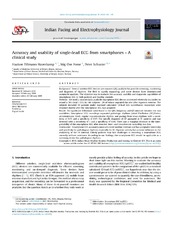| dc.contributor.author | Haverkamp, Haakon Tillmann | en_US |
| dc.contributor.author | Fosse, Stig Ove | en_US |
| dc.contributor.author | Schuster, Peter | en_US |
| dc.date.accessioned | 2020-08-13T13:16:58Z | |
| dc.date.available | 2020-08-13T13:16:58Z | |
| dc.date.issued | 2019 | |
| dc.Published | Haverkamp, Fosse SO, Schuster PM. Accuracy and usability of single-lead ECG from smartphones - A clinical study. Indian Pacing and Electrophysiology Journal. 2019;19(4):145-149 | eng |
| dc.identifier.issn | 0972-6292 | |
| dc.identifier.uri | https://hdl.handle.net/1956/23751 | |
| dc.description.abstract | Background: Several wireless ECG devices are commercially available for possible screening, monitoring and diagnosis of rhythms. The field is rapidly expanding, and some devices have demonstrated acceptable qualities. The objective was to evaluate the accuracy, usability and diagnostic capabilities of smartphone ECG in both patients and healthy controls. Methods: We used a commercially available smartphone ECG device, connected wirelessly to a tablet, to record a 30-s lead I ECG in 144 subjects—20 of whom repeated the test after vigorous exercise. The subjects included 94 patients under standard calculated 12-lead ECG surveillance; transcripts were obtained shortly after the smartphone ECG was acquired. Results: No significant differences were found in the QRS, frequency and QT intervals between the two modalities. Smartphone ECG recordings separated pathologic rhythms (atrial fibrillation (AF)/flutter, atrioventricular block, regular supraventricular rhythm, and pacing) from sinus rhythms with a sensitivity of 0.75 and a specificity of 0.97. The specific diagnosis of AF appeared in 11 patients and was detected with a sensitivity of 1 and a specificity of 0.94. There was a marginal decrease in the interpretability of the smartphone ECG after exercise. Inter- and intraobserver variability was low. Conclusions: Smartphone ECG accurately measures most baseline intervals and has acceptable sensitivity and specificity for pathological rhythms, especially for AF. Vigorous activity has a minor influence on the readability of the PR interval. Elderly patients may face challenges in recording a smartphone ECG correctly without assistance. According to our findings, the smartphone ECG would be applicable as a screening device for pathological rhythms. | en_US |
| dc.language.iso | eng | eng |
| dc.publisher | Elsevier | eng |
| dc.rights | Attribution-Non Commercial-No Derivatives CC BY-NC-ND | eng |
| dc.rights.uri | http://creativecommons.org/licenses/by-nc-nd/4.0/ | eng |
| dc.title | Accuracy and usability of single-lead ECG from smartphones - A clinical study | en_US |
| dc.type | Peer reviewed | |
| dc.type | Journal article | |
| dc.date.updated | 2019-12-06T13:18:55Z | |
| dc.description.version | publishedVersion | en_US |
| dc.rights.holder | Copyright 2019, Indian Heart Rhythm Society | |
| dc.identifier.doi | https://doi.org/10.1016/j.ipej.2019.02.006 | |
| dc.identifier.cristin | 1714249 | |
| dc.source.journal | Indian Pacing and Electrophysiology Journal | |

